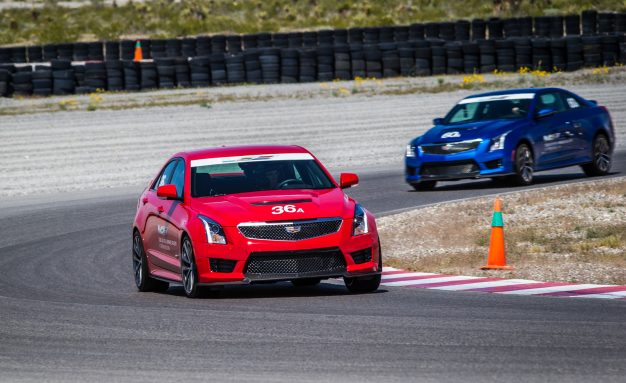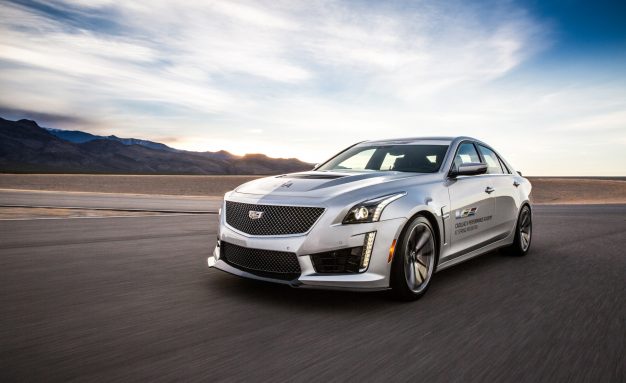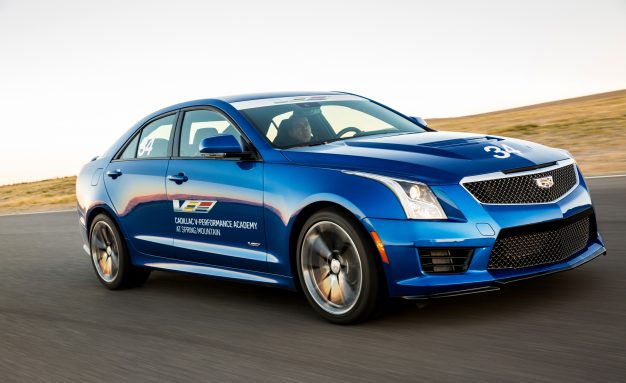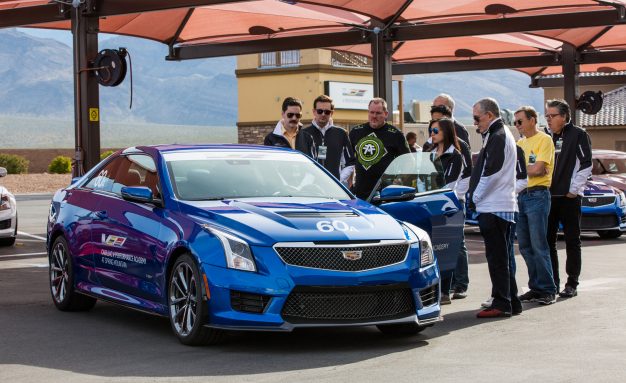–
The rubber industry owes a debt of gratitude to Cadillac. More than a decade and a half after the Escalade helped usher in an era of plus-size wheels and tires to mass-market consumers, the American luxury brand now actively encourages owners of its ATS-V and CTS-V to burn through tires at the racetrack. The brand’s V-Performance Academy is a two-day high-performance driving school that comes standard with the purchase or lease of a new 2017 Cadillac ATS-V or CTS-V.
–
Lessons are conducted at Spring Mountain Motor Resort and Country Club in Pahrump, Nevada, an automotive playground located approximately 53 miles west of McCarran International Airport in Las Vegas. Enrollment in the academy includes two nights’ lodging at Spring Mountain’s onsite condos, a Cadillac courtesy vehicle, transportation to and from the airport, and breakfast and lunch as well as one dinner. Airfare, though, is not included, and 2017 ATS-V and CTS-V customers have one year after delivery of the vehicle to take advantage of the offer before it expires.
–
–
Cadillac’s hope is that ATS-V and CTS-V customers will learn to better understand and make use of the immense performance potential built into their cars by attending the school, which is designed to teach enrollees proper high-performance driving techniques as well as educate them about their vehicle’s specific technology features. While the brand wouldn’t share with us how many 2017 ATS-V and CTS-V consumers have Cadillac up on its offer to attend the V-Performance Academy free of charge, a Cadillac spokesperson stated that the Academy’s popularity has resulted in more classes being added to Spring Mountain’s calendar. Enrollees need not be owners of a 2017 ATS-V or CTS-V, either; non-owners may attend the V-Performance Academy at a starting price of $ 2470 per customer.
–
While these paying customers can choose whether their time at the school is spent behind the wheel of an ATS-V or a CTS-V, owners enrolled on Cadillac’s dime are given seat time in a car that mirrors their own personal purchases. All of the Cadillacs used by the instructors and students of the V-Performance Academy wear the same grippy, street-legal Michelin Pilot Super Sport tires offered on ATS-V and CTS-V models sold at Cadillac dealerships, without special track preparations. The Graphite Gray Metallic CTS-V we were placed in included comfortable 20-way heated and ventilated power seats, tri-zone automatic air conditioning, and a massive panoramic sunroof. Nor has Spring Mountain touched the cars’ mechanicals: ATS-Vs at the track are motivated by a stock 464-hp twin-turbocharged 3.6-liter V-6 engine mated to either a six-speed manual or eight-speed automatic transmission, while CTS-Vs maintain their raucous 640-hp supercharged 6.2-liter V-8 paired to an eight-speed automatic.
–
Spring Mountain, with its sprawling six-plus miles of tarmac, offers up to 18 different track configurations ranging from the 1.0-mile South course to the 6.1-mile SM Long course. Cadillac’s V-Performance Academy uses the tight and twisty 1.5-mile West course. Before letting students ever put a tire on the tarmac, the Academy’s instructors first engage in a brief safety talk and vehicle introduction. It’s at this point that instructors begin etching into students’ minds the importance of looking toward the next turn rather than at the turn ahead. They also begin familiarizing drivers with the cars’ traction and stability control setups, as well as proper seating position. Only then do students take the wheel, first completing a slalom, then braking at full force in both wet and dry conditions and snaking through a serpentine, low-speed course dotted with a handful of strategically placed cones that serve as turning points. Success in the serpentine is determined by looking through the turn and not at the turn ahead. To drive this point home, Academy instructors place a sun visor on the windshield of each student’s vehicle and ask him or her to complete the serpentine without any ability to look at the nearest turn.
–
–
Academy instructors aren’t done, though, as students are then ferried off to another area of Spring Mountain that features two small courses: a wet figure eight and a dry oval. The former course lets students put the lessons they learned weaving in and out of the serpentine to the test—only now with much less traction. The latter allows the driver to perfect his or her ability to turn on an apex. Both activities also test each student’s ability to control oversteer and understeer. Once all of these activities have been completed, students are allowed onto the entire 10-turn West course.
–
While Day One ends with a quick run around the West course, all of Day Two’s driving activities are done while lapping the curvy course in lead-follow sessions. Between driving sessions, instructors go over the cars’ technology features, including the standard Performance Traction Management (PTM) system and the $ 1600 Performance Data Recorder (PDR).
–
PTM provides five track-ready settings under the Track driving mode (there are also Tour and Sport driving modes): Wet, Dry, Sport 1, Sport 2, and Race. Progressing from Sport 1 to Sport 2 to Race mode loosens the reins of the vehicle’s traction and stability control systems, allowing the driver to operate with more slip and less electronic intervention. Instructors direct students to drive the course in Sport 1. While we’d likely have had more fun with our CTS-V’s nannies set to Sport 2 or Race, the cantankerous Caddy proved a mighty handful even in Sport 1 thanks to the West course’s short straightaways and tight turns.
–
–
If PTM is an on-track tool, then PDR is an off-track one. The system contains a windshield-mounted camera that’s able to record drives onto a removable memory card housed in the glovebox. In theory, PDR is little more than a factory-mounted dashboard camera; however, ATS-V and CTS-V models equipped with the system are also able to overlay performance information such as vehicle speed, engine speed, lateral g-forces, and steering angle. Videos can be viewed on the cars’ center-stack touchscreen or on a computer. Frankly, the PTM and PDR portions of the academy will feel like a time-share presentation to students who don’t own an ATS-V or a CTS-V. Nevertheless, ATS-V and CTS-V owners attending the school will likely appreciate the in-depth analysis given toward their vehicles’ available features and functions.
–
Regardless, the V-Performance Academy is an impressively thorough two-day performance driving school that provides valuable experience to ATS-V and CTS-V owners and non-owners alike. We believe a longer track configuration would allow CTS-V owners to take greater advantage of that car’s immense power, while an opportunity to take a few laps without an instructor car leading the way (an option not offered) would also be a welcome addition.
–
- –
- Book by Cadillac Promises Caddy without Commitment
- Full Test: The 2017 Cadillac ATS Sedan V-6 Shoulda Been a Contender
- Cadillac CTS-V Research: Pricing, Specs, Reviews, and More!
–
–
–
–
Still, the instructors are happy to go toe to toe with each student’s capability. As we continued to push our CTS-V’s limits around the little loop, we found that by the end of the second day our car’s Michelin tires were becoming increasingly greasy with each and every lap. While the tires never became so slick as to shake our confidence, the four contact patches felt just loose enough to let us know that our $ 94,075 supersedan would need its rubber replaced soon, ensuring Cadillac’s continued contribution to the health of the tire industry.
–
–









